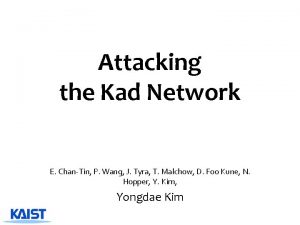Attacking Kad Network 20090304 Hongil Kim E ChanTin















- Slides: 15

Attacking Kad Network 20090304 Hongil Kim E. Chan-Tin, P. Wang, J. Tyra, T. Malchow, D. Foo Kune, N. Hopper, Y. Kim, "Attacking the Kad Network - Real World Evaluation and High Fidelity Simulation using DVN -", Wiley Security and Communication Networks 2009 1

P 2 P Applications � File Sharing : Napster, Gnutella, Bit. Torrent, etc � Recent Commercial Applications Skype Bit. Torrent becomes legit P 2 P TV by Yahoo Japan � Research community P 2 P File and archival systems: Ivy, Kosha, Oceanstore, CFS Web caching: Squirrel, Coral Multicast systems: SCRIBE P 2 P DNS: Co. DNS and Co. Do. NS Internet routing: RON Next generation Internet Architecture: I 3 2

P 2 P Systems � How to find the desired information? Napster. com Centralized structured: Napster Decentralized unstructured: Gnutella Match Decentralized structured: K Napster V Distributed Hash Table O K V O ▪ Content Addressable! K V � A DHT provides a hash table’s simple put/get interface K V P Insert a data object, i. e. , key-value pair (k, v) K V Retrieve the value v using key k P: a node looking for a file V B O: offerer of. Athe. Kfile … K V Query. Hit X Download retrieve (K 1) 3

DHT: Terminologies Every node has a unique ID: node. ID Every object has a unique ID: key Keys and node. IDs are logically arranged on a ring (ID space) � A data object is stored at its root(key) and several replica roots � � � Closest node. ID to the key (or successor of k) Range: the set of keys that a node is responsible for � Routing table size: O(log(N)) � Routing delay: O(log(N)) hops � Content addressable! � C Q A X D B Y R k (k, v) 4

Target P 2 P System � Kad A peer-to-peer DHT based on Kademlia � Kad Network Overnet: an overlay built on top of e. Donkey clients ▪ Used by P 2 P Bots Overlay built using e. D 2 K series clients ▪ e. Mule, a. Mule, MLDonkey ▪ Over 1 million nodes, many more firewalled users BT series clients ▪ Overlay on Azureus ▪ Overlay on Mainline and Bit. Comet 5

Kademlia Protocol 01001011 123. 24. 3. 1 00100101 23. 37. 12. 13 01011010 311. 1. 3. 4 … 01000001 129. 5. 3. 1 0 1 11011011 11000100 11111110 11001011 0 1 … 11010001011 10010100 10001110 … 0 1 10000001 1 � � 11000100 1100 Find/store 11001010 0 d(X, Y) = X XOR Y An entry in k-bucket shares at least k-bit prefix with the node. ID k=20 in overnet � 10101100 K bucket 10101100 Add new contact if k-bucket is not full Parallel, iterative, prefix-matching routing � Replica roots: k closest nodes � 6

Kad Protocol 10101100 1 1 0 1 0 15 14 13 12 0 1 1 0 11 10 1 9 1 0 8 1 7 0 0 0 6 1 5 1 0 4 3 0 2 1 0 0 1 1 � � � 1 0 0 No restriction on node. ID Replica root: |r, k| < K buckets with index [0, 4] can be split if new contact is added to full bucket Wide routing table short routing path K bucket in i-th level covers 1/2 i ID space A knows new node by asking or contact from other nodes � Hello_req is used for liveness � � � routing request can be used 7

Vulnerabilities of Kad � No admission control, no verifiable binding An attacker can launch a Sybil attack by generating an arbitrary number of IDs � Eclipse Attack Stay long enough: Kad prefers long-lived contact (ID, IP) update: Kad client will update IP for a given ID without any verification � Termination condition Query terminates when A receives 300 matches. � Timeout When M returns many contacts close to K, A contacts only those nodes and timeouts. 8

Actual Attack �Preparation phase Backpointer Hijacking: 8 A, attacker M ▪ Learns A’s Routing Table by sending appropriate queries ▪ Then, change routing table by sending the following message. 0 x. D 00 D IPMB A Hello, B, IPM M �Execution phase Provide many non-existing contacts ▪ Fact: Query will timeout after trying 25 contacts. 9

Screen Shots 10

Summary of Estimated Cost � Assumption Total 1 M nodes 800 routing table entries 100 Mbps network link � Preparation cost 41. 2 GB bandwidth to hijack 30% of routing table Takes 55 minutes with 100 Mbps link � Query prevention 100 Mbps link is sufficient to stop 65% of WHOLE query messages. 11

Large scale simulation � 11, 303 ~ 16, 105 Kad nodes running on ~500 Planet. Lab machines ^ Comparison between expected and measured 4 keyword query failures 4 Number of messages used to attack one node 4 Bandwidth usage 12

Self reflection attack � Fill node A’s routing table with A itself. A C IPC … G IPG A C Hello, X, IPA G Attack C … G C G ^ ≈ 100% queries failed after attack ^ Nodes can recover slowly ^ Second round of attack 13

Mitigations � Identity authentication Method Secure Persistent ID Incremental deployable Verify the liveness of old IP No Yes Drop Hello with new IP Yes No Yes ID=hash(IP) Yes No No ID=hash(Public Key) Yes No � Routing correctness Independent parallel routes ▪ Incrementally deployable backpointers Current method Independent parallel routes 40% 98% fail 45% fail 10% 59. 5% fail 1. 7% fail 14

Thank you Any Questions?
 Kretanje zemlje oko sunca
Kretanje zemlje oko sunca Kad je senka najduza a kad najkraca
Kad je senka najduza a kad najkraca Yellow throated marten attacking a panda
Yellow throated marten attacking a panda Attacking and defending castles
Attacking and defending castles Example of attacking the motive fallacy
Example of attacking the motive fallacy 5 characteristics of skilled performance
5 characteristics of skilled performance Beltlining and blame are two face-attacking strategies.
Beltlining and blame are two face-attacking strategies. Chameleon attacking in dream
Chameleon attacking in dream Bloodborne pathogens attacking the liver are
Bloodborne pathogens attacking the liver are The attacking firm goes head-to-head with its competitor.
The attacking firm goes head-to-head with its competitor. Nesmagu kad liekat vienas
Nesmagu kad liekat vienas Kodėl galime teigti, kad vanduo yra skaidrus kūnas?
Kodėl galime teigti, kad vanduo yra skaidrus kūnas? Kad te netko ne voli
Kad te netko ne voli Kad pobijedi ljubav kviz
Kad pobijedi ljubav kviz Bijeli jelen kviz
Bijeli jelen kviz Bērniņ neēd kad dziesmu dzied
Bērniņ neēd kad dziesmu dzied





























